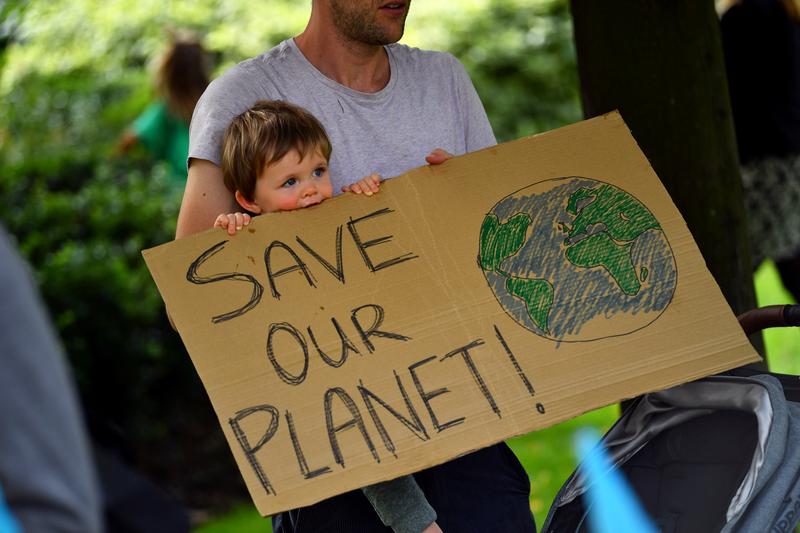Humanity Is ‘A Weapon Of Mass Extinction’
Dec 19, 2022 | Pratirodh Bureau
A father and his child hold a sign at a protest by climate activists in London, Britain (Representational Image)
Humanity is at war with nature and on its last chance to reverse the rampant destruction of habitats that will condemn thousands of species to extinction and threaten our own existence.
“With our bottomless appetite for unchecked and unequal economic growth, humanity has become a weapon of mass extinction,” UN chief Antonio Guterres told delegates gathered in Montreal for COP15, the United Nations’ biodiversity conference.
The conference kicked off on December 7 and will end today, December 19, during which it is hoped a new biodiversity framework of more than 20 targets will be adopted, the first since targets were agreed in 2010.
There is mounting evidence the world is experiencing its largest loss of life since the dinosaurs. One million plant and animal species are now threatened with extinction.
“We’ve already degraded 75 per cent of the Earth’s surface and more than 60 per cent of the marine environment,” the UN’s biodiversity chief Elizabeth Maruma Mrema told the BBC.
Corey Bradshaw, Matthew Flinders professor of global ecology at Flinders University, says if the current rate of extinction continues we could lose most species by 2200. The implication for human health and wellbeing is dire, but not inevitable.
Preserving biodiversity is crucial to keeping global warming to 1.5 degrees, say the architects of the Paris climate agreement.
A healthy planet also ensures resilient economies. More than half of global GDP – equal to US$41.7 trillion – is reliant on healthy ecosystems.
Researchers and scientists have explored what’s already working to protect biodiversity. Evidence in the seven areas below shows there are simple measures that work, and others that will require global collaboration.
Consider what we eat and waste less
Expanding agricultural land is pushing biodiversity past a safe limit, says Quentin Read, data scientist and ecologist at North Carolina State University. “Some species may already be ‘walking dead’, doomed to extinction because they no longer have a habitat large enough to avoid a population crash.”
An important part of the solution is helping consumers better understand how their diets and food waste behaviours influence global biodiversity. “Animal products need large amounts of land to grow feed and pasture livestock. A smart plant-based diet is a major way to reduce land demand and biodiversity impact relative to a diet high in meat and dairy.”
But even for those unwilling or unable to change their diet, Read says reducing pre-consumer and consumer food waste by 50 percent has almost as much positive impact on reducing land demand in high-biodiversity areas.
Make cities more wildlife friendly
Cities can be hostile places for plants and animals, say Sarah Bekessy, sustainability and urban planning teacher at RMIT University and Georgia Garrard, senior lecturer in sustainability at the University of Melbourne.
But with “policy rethink and clever designs, cities could be safe havens for species to thrive and recover”.
“New solutions, like biodiverse green roofs, habitat boxes and insect hotels can also provide food and shelter for a range of animals in cities. Stormwater runoff which can negatively impact native plants and animals such as frogs can be mitigated by vegetated swales and rain gardens.”
Worldwide, domestic cats are responsible for over a quarter of modern mammal, bird and reptile extinctions, says Sarah Legge, ecologist and invasive species expert at the Australian National University.
The urgency has forced scientists to innovate. “Fenced enclosures, cat eradications from islands, new poison delivery systems, smart fire and grazing management are just some of the tools keeping native species from extinction. Reducing the impacts of pet cats is much simpler than controlling feral cats – just keep them contained, as almost a third of cat owners already do.”
Spend more to protect forests and habitats on land and in water
Investing in people to carry out conservation would have far reaching benefits, says Euan Ritchie, professor in wildlife ecology and conservation at Deakin University.
Ritchie says it would cost around A$1.7 billion a year to bring all the species on Australia’s threatened list back to health. Australia currently spends around A$120 million a year on targeted threatened species conservation and recovery.
“Australian governments and society seemingly don’t see the environment as a priority investment. The question we must confront is why?”
Keep working to conserve endangered species
Early action to prevent decline and critical endangerment would be a more cost-effective approach to prevent species loss than captive breeding programs and reintroduction, says Philip McGowan, professor of conservation science and policy at Newcastle University.
“The strategies to save species are available and … effective. What remains lacking is the widespread support for and adoption of these and emerging approaches. Extinction is not inevitable.”
Learning from previous and current management by local and Indigenous people and fostering shared fire management are invaluable steps in promoting fires that benefit people and biodiversity, say wildfire researchers.
Research in New Zealand, for example, has identified low-flammable vegetable crops, pastures and traditional Māori food and medicine species, such as the kawakawa tree, that could moderate fire while enhancing biodiversity.
Abolish our goal of perpetual economic growth
Most of the damage to the Earth’s life-support system has happened over the last century, says Corey Bradshaw.
“The global human population has tripled since 1950, and there are now approximately one million species threatened with imminent extinction due to massive population declines. To reverse that we could abolish the goal of perpetual economic growth, and force companies to restore the environment using established mechanisms such as carbon pricing. We could limit undue corporate influence on political decision-making, and end corporate lobbying of politicians. Educating and empowering women, including providing greater self-determination in family planning, would help stem environmental destruction.”
